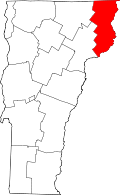Mount Orne Bridge | |
|---|---|
 View of the bridge from the south | |
| Coordinates | 44°28′N71°39′W / 44.46°N 71.65°W |
| Crosses | Connecticut River |
| Locale | Lancaster, New Hampshire to Lunenburg, Vermont |
| Maintained by | Towns of Lancaster and Lunenburg |
| ID number | 29-04-08 (NH #30) |
| Characteristics | |
| Design | Howe truss bridge |
| Total length | 266.25 ft (81.15 m) |
| Width | 20.5 ft (6.25 m) (maximum), 14.42 ft (4.395 m) (roadway) |
| Longest span | 127.33 ft (38.81 m) |
| Load limit | 6 tons |
| Clearance above | 12.75 ft (3.89 m) |
| History | |
| Opened | 1911 |
| Closed | |
Mount Orne Covered Bridge | |
| Location | Lancaster, New Hampshire & Lunenburg, Vermont |
| Coordinates | 44°27′36″N71°39′10″W / 44.46000°N 71.65278°W |
| Area | 1 acre (0.40 ha) |
| Architect | Berlin Iron Bridge Co. |
| Architectural style | Howe truss covered bridge |
| NRHP reference No. | 76000124 [1] |
| Added to NRHP | December 12, 1976 |
The Mount Orne Bridge is a covered bridge over the Connecticut River between Lancaster, New Hampshire, and Lunenburg, Vermont. It joins Elm Street (New Hampshire Route 135) in South Lancaster with River Road (Town Highway 1) in Lunenburg. Built in 1911, it is one of two Howe truss bridges across the Connecticut River. It was listed on the National Register of Historic Places in 1976. [1]




